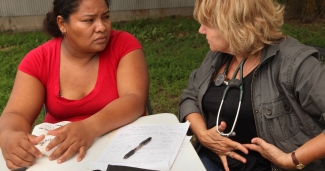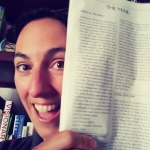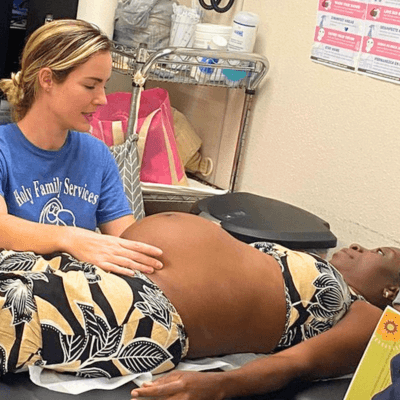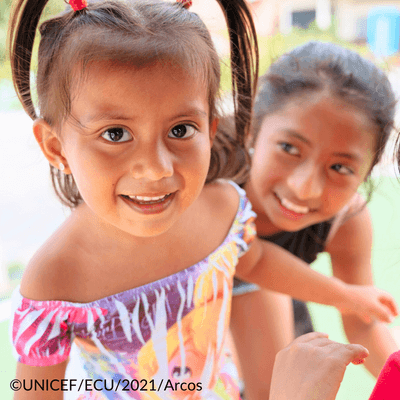Witnessing: How Clinicians Can Move From Traumatic Stress to Empowerment While Serving Their Immigrant Patients
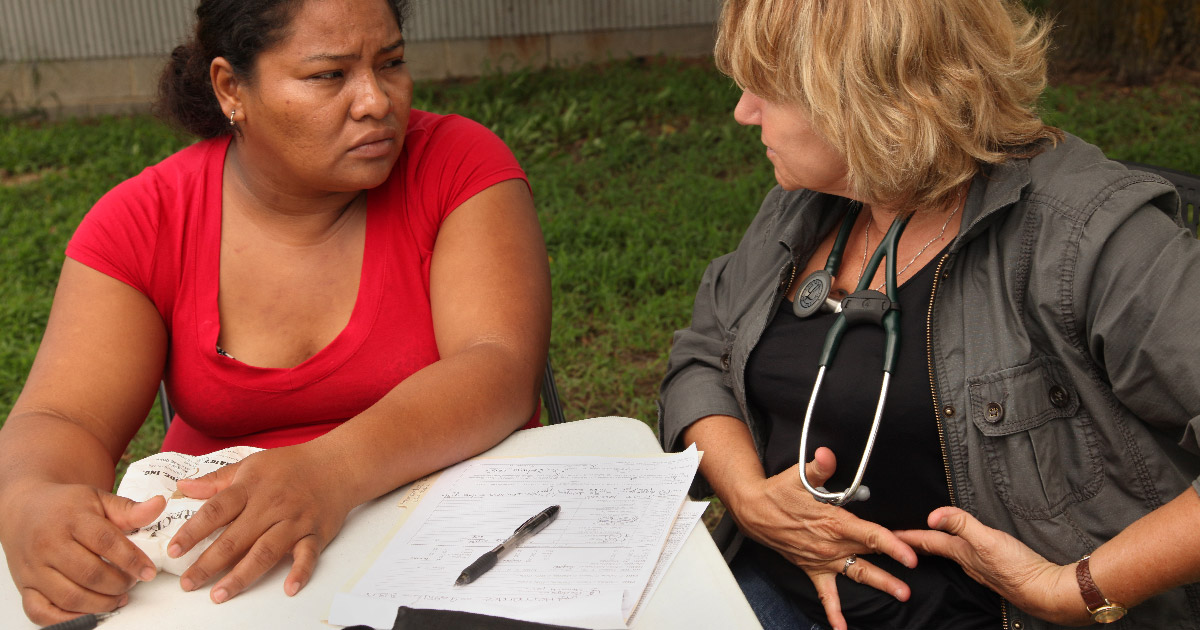
(photo by Earl Dotter)
When Kaethe Weingarten, PhD, first entered clinical practice as a psychologist and family therapist in 1970s Boston, she began to notice a common theme among her work with children: traumatized parents. At a local children’s hospital, parents were overwhelmed while observing their children undergo treatments and procedures. In a very different setting at a mental health clinic for children who experienced sexual abuse, she saw non-offending parents struggling to observe what their children were going through. Despite the very different settings, the parents had similar strong and intense reactions. “Obviously, the parents weren’t the victims -- they weren’t in the child’s position of having something traumatic happening to them -- and they weren’t the perpetrators. They were bystanders. But ‘bystanders’ didn’t cover it, because the parents were traumatized,” Dr. Weingarten recalled. “The experience of parents watching their children are in a witness position.” She began to write on the idea of “witnessing,” a combination of bystander theory and the newly emerging trauma theory.
“Far and away the vast majority of violence or violation that anyone experiences is from the witnessing position,” Dr. Weingarten noted, and the type of traumatic experiences that people witness are widely varied. “The more I delved into it, the more I believed that there wasn’t any one position [of witnessing] but there was a wide range of context; not just a medical context or a domestic violence context, but other forms of violence, and all the way up to [witnessing] genocide.” Dr. Weingarten has expanded on witnessing theory, seeking to help people in the witnessing position to step into a position of empowerment over helplessness, thereby guarding them from the negative effects of witnessing trauma and potentially helping them find a way to take effective action from their position as witness. “Depending on the setting and the problem they’re facing, there are all kinds of ways that people can move up into an aware and empowered witness position, which really is the only one that has any long-term staying power.”
For clinicians serving migrants and immigrants, the witnessing model and Dr. Weingarten’s efforts to help witnesses out of helplessness and into empowerment have substantial and relevant applications. “The situation for families crossing the border and people seeking asylum [has been] increasingly dire,” Dr. Weingarten notes. Clinicians are struggling to provide accurate advice to their patients as the immigration landscape rapidly shifts on issues like public charge and fear continues to be used as a tool to uproot immigrant families from their communities. A recent MCN poll of clinicians found that 65 percent of respondents had seen a change in the previous year in immigrant or migrant patients’ attitudes toward health care access; most poll respondents named an increase in fear and anxiety around immigration policy as the primary change. Witnessing the fear, anxiety, and uncertainty of their patients, and watching as more patients opt out of accessing health care as a result, many clinicians feel stuck and unable to do their jobs effectively. A common result is an empathic stress reaction.
In Dr. Weingarten’s witnessing model, which she lays out in her book Common Shock: Witnessing Violence Every Day: How We Are Harmed, How We Can Heal, Dr. Weingarten identifies three manifestations of such an empathic stress reaction that a clinician working with migrants or refugees may experience. The first, burnout, is already widely associated with clinical work: a long-term work situation wherein the mounting stress inhibits a clinician’s ability to work effectively. The second type of stress reaction, secondary traumatic stress, can arise suddenly after a clinician learns about a patient’s traumatic experience. Fear, horror, and helplessness may plague the clinician and disrupt the clinicians’ ability to be effective. A third manifestation is vicarious traumatization, wherein a clinician’s repeated work with traumatized patients reshapes a clinician’s worldview around the clinician’s personal safety and the potential for harm. In essence, it changes the way we perceive our and our family’s safety. Dr. Weingarten’s work now, she says, is to help those witnesses cope with their stress and trauma
“What is it that helps the helpers continue to be able to help? My view is that it’s essential that people who are directly witnessing the families have [their own] support,” Dr. Weingarten emphasized. “There are all kinds of ways that people can move up into the aware and empowered witness position, which really is the only one that is effective long-term.” Talking through the witness’s experiences and reactions with an empathetic listener is just one method; read the text box for extensive recommendations from Dr. Weingarten on addressing clinician trauma and becoming an “empowered witness”.
Access resources on witnessing provided by Dr. Weingarten on our resources page:
https://www.migrantclinician.org/toolsource/resource/witnessing-resources.html
Learn more about witnessing at Dr. Weingarten’s webpage: www.witnessingproject.org
Read more about Common Shock with links to various online stores for purchase on GoodReads
Recommendations for Clinicians
In the following excerpt from Common Shock, Dr. Weingarten outlines some recommendations that may be useful for clinicians who are experiencing trauma as a result of their position as witness. They are broken down by biological, psychological, interpersonal, and societal. These recommendations assume that you are currently safe.
A. The Biological Consequences of
Common Shock:
1. Learn to recognize how your body feels when it is experiencing stress. For instance, do you notice your heart beating faster, your breath feeling tight, a knot or butterflies in your stomach, your thoughts racing or slowed down, difficulty swallowing?
2. Use your breath as an anchor to feel calmer. Inhale slowly to a count of three, hold your breath to a count of three, and exhale to a count of three. Repeat this sequence until you notice you are breathing more easily.
3. Sometimes as a person releases pent up stress from a common shock experience, the body trembles involuntarily. This is a natural and healthy response.
4. Make a list of 10 activities that comfort you, for instance listening to a particular piece of music or taking a hot shower. Keep the list in your wallet or someplace where it is always handy and do one activity each day.
5. Avoid overusing stimulants like caffeine, alcohol, sugar or drugs, but do drink plenty of fluids and eat comforting, nutritious foods in moderation.
6. Balance vigorous exercise with relaxing exercise, e.g. running with stretching.
7. Take a warm shower or bath.
8. Try sitting on the ground. Many people find placing their bodies on the ground is comforting. If this is not possible, sit in a chair and feel the sensation of your buttocks and the backs of your legs on the chair.
9. Look at some object of natural beauty. Even one will do. Study a leaf, notice the way the light looks, look at a rock. Take a walk in a park or in an area where grass, plants or trees grow.
10. Light a candle and dedicate the light to something or someone whose presence near you will be comforting.
B. The Psychological Consequences of Common Shock
1. Tell your experience to someone you trust. Don’t worry if you are getting the details right; convey your overall sense of your experience.
2. Let yourself release the feelings you have. If you feel sadness, cry; if anger, yell.
3. Create an image for yourself that makes you feel part of a larger group. For instance, imagine that you are one animal in a large herd of animals or imagine that your hands are linked in a human chain that spans the globe. Use this image several times a day, perhaps before you do your breathing exercise.
4. Think of one small action that you can take, symbolic or actual, that makes you feel less helpless.
5. If you are feeling afraid in the present when you know you are actually safe, ask yourself the following questions: Am I safe now? How is the present moment different from the time when I was in danger? What can I do now to comfort myself?
6. Express yourself in an artistic medium: sing, draw, bang on plastic container “drums,” dance, make a collage, etc.
7. If you feel shame, consider whether it is appropriate or not. This is a very hard idea to consider, but well worth it. If you feel ashamed of something you have done, think of a way you can make amends. Consider asking someone to help you figure this out, if it is too overwhelming to imagine what you might do to make amends. If you feel shame, but you don’t believe that you have really done anything to deserve it, consider that someone may have “dumped” – transferred – his or her unbearable feelings of shame on to you. You may want to confront the person or, again, create a ritual. For a ritual, you might want to cleanse yourself of your undeserved shame by burning or burying a symbolic representation of it.
8. Do not expect a lot of yourself. Cut yourself slack.
9. Spend time with people who care about you.
10. Let others comfort you. If others need comfort, comfort them.
11. Hug friends and family members.
12. Give yourself time to heal.
C. Interpersonal Consequences of Common Shock
1. Silence: It is important to feel safe and to share your experience with at least one other person whom you trust to listen carefully and to decide with you what, if any, next steps you might take to feel better and/ or to act in relation to the situation you have witnessed. In many situations it may seem impossible both to tell someone and maintain your own and/or others’ safety. However, ultimately silence or secrecy seldom keeps people safe. These are difficult choices, but speaking out has a better chance of leading to improvement than silence.
2. Shattered Assumptions: Assumptions are not like glass; they are built out of experiences in the world with others and these experiences can change. When “shattered,” with time, with support from others and with distance from the experiences that produced the collapse of core beliefs, related ones will form. These will form in new ways to accommodate both prior and new experience. It is unlikely that you will emerge the same, which may produce its own interpersonal challenges. But the changes can usually be placed in a context that makes them understandable to others.
3. Inhibition of Self-Disclosure: There are often times when a person needs to talk, but others cannot bear the story he has to tell. This invariably creates a sense of isolation and may deepen grief and loss. As sad as this circumstance is, it is rarely total. You may have to manage your disappointment that the person you most want to talk to is unavailable, but there will usually be someone available. If no one you know is willing to listen to you, look in your area for support groups led by trained professionals. Group discussion can be very beneficial when your own support networks are depleted. Or, you can seek professional help. You can contact your state’s professional organizations of psychology, social work, marriage and family counseling, or psychiatry for referral information.
4. Problems of Fit: It is highly unlikely that any two people, even or especially life partners, will manage common shock identically, initially or over time. As painful as this can be, it is helpful to accept this as fact. Both parties should try to be clear and direct about their needs to their partner, friend or family member and both should be candid in return about what they can and cannot provide. Try not to turn to people for something you know they cannot provide. Look for other sources of support. Trust that when the situation is more stable, the discoveries you have made regarding problems of fit can be discussed and that incremental changes in preferred directions can be made.
D. Societal Consequences of Common Shock
In a calm moment of reflection, ask yourself the following question: Has violence, retaliation or revenge ever produced lasting peace and harmony in families, communities or nations at any time or in any place in history?
Like what you see? Amplify our collective voice with a contribution.
Got some good news to share? Contact us on our social media pages above.
Return to the main blog page or sign up for blog updates here.
- Log in to post comments
